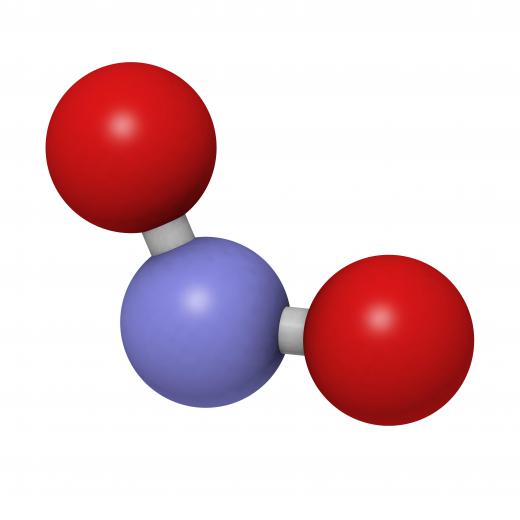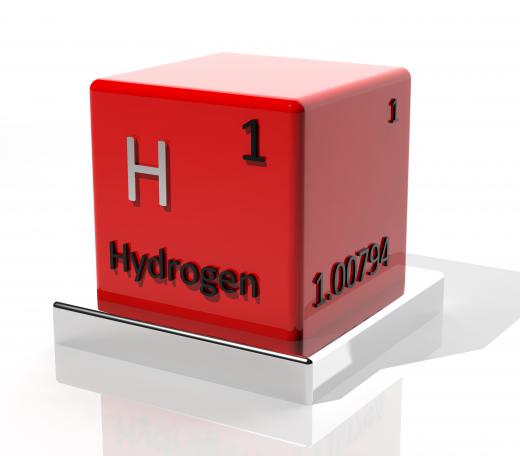What is a Hydrogen Bond?
 Michael Anissimov
Michael Anissimov
A hydrogen bond is a relatively weak bond that hydrogen atoms make with the electronegative atoms nitrogen, oxygen or fluorine. Hydrogen bonds are weaker than ionic, covalent, and metallic bonds, but still mildly strong in their own right, with an energy typically between 5 to 30 kJ/mole. In contrast, weak covalent bonds have an energy of about 155 kJ/mol. Hydrogen bonding can either be an intermolecular (between molecules) or intramolecular (between different parts of a molecule) bond. This type of bond can occur in both organic molecules, such as DNA, and inorganic molecules, such as water. Hydrogen bonding is partially responsible for the complex secondary and tertiary structure of proteins.
The most ubiquitous and simplest example of hydrogen bonding is in water, where every water molecule is bonded to four adjacent water molecules through hydrogen bonding. The oxygen atom in each water molecule has two lone electrons to offer, which are promptly bonded with by hydrogen atoms in other water molecules. Furthermore, the two hydrogen atoms attached to every oxygen bond to the oxygen molecules in adjacent water molecules. This intermolecular bonding is responsible for the relatively high boiling point of water. Water has an extremely high boiling point relative to materials consisting of molecules of similar size. If these bonds didn't exist, water would boil at a temperature similar to carbon dioxide (which boils at -78 °C or -108.4 °F) and life as we know it would be impossible.

A hydrogen bond consists of a hydrogen bond acceptor, the target atom, and a hydrogen bond donor, the hydrogen atom itself. Sometimes, in molecules such as chloroform (CHCl3), carbon can get involved in hydrogen bonding, especially when surrounded by electronegative atoms such as chlorine. A hydrogen bond is unusual and often called an electrostatic dipole-dipole interaction (a weak intermolecular interaction), lumping it in with more transient bonds caused by momentary quantum fluctuations in electric charge, but it also has many characteristics of the much stronger covalent bonds, where electron clouds actually overlap directly. These characteristics include directionality, strength, the production interatomic distances shorter than those typical in transient van der Waals interactions, and a limited number of interaction partners, which is diagnostic of stronger bonds.

The length of hydrogen bonds vary depending on bond strength, temperature, and pressure. The bond strength is also dependent on a number of factors, including temperature, bond angle, pressure, and environment. In water, the typical length of a hydrogen bond is 1.97 Å (197 pm).
AS FEATURED ON:
AS FEATURED ON:













Discussion Comments
@ GenevaMech- They are in fact different types of bonds. When non-metal anions like carbon and hydrogen bond with a metallic anion, they form ionic compounds. These are compounds where anions and cations swap electrons, creating positive and negative charges, which in turn cause a strong attraction. The attraction between ions is much stronger than the attraction created by a hydrogen bond.
The unique thing about hydrogen is that it can break the rules when forming ionic compounds. Hydrogen can become either a cation or an anion because it will be happy with two or no electrons in its outermost electron shell. This is because the first electron shell only holds two electrons, and hydrogen normally has one so it can either donate or accept an electron to be happy. However, the most common hydrogen ion on earth is the hydrogen cation, which holds no electrons thus taking the positive charge of the lone proton.
Is a hydrogen bond the same as a hydrogen ionic bond? If someone could help me understand the difference between the two types of bonds, I would appreciate it. Thanks!
The easiest way for me to remember a hydrogen bond is the weakest bond is to think of how it affects waters properties. The hydrogen bond that occurs in water is what gives water surface tension. A hydrogen bond is strong enough to support a water skier, water bug, or create droplets instead of steam when something creates a splash, but they are weak enough to allow water to flow and conform to surfaces.
Post your comments